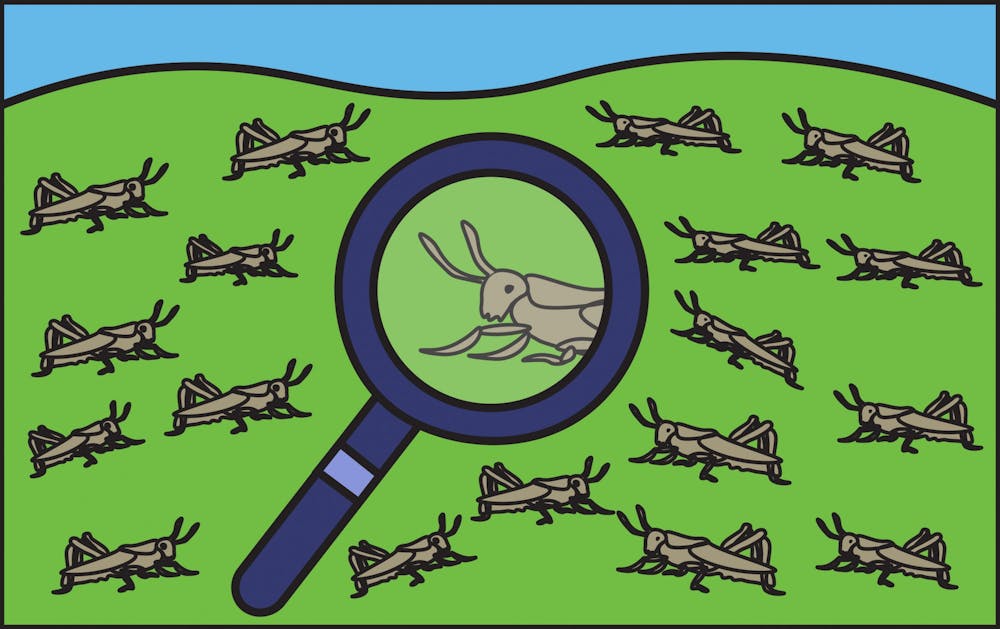ASU’s Global Locust Initiative is working together with researchers and international and government agencies around the globe in order to support the fight against locust outbreaks like the ones in East Africa and South America.
Desert locusts are swarming throughout countries in East Africa destroying crops and livelihoods in an already at-risk region, prompting Somalia to declare a state of emergency over the infestation.
“If infestations are not detected and controlled, devastating plagues can develop that often take several years and hundreds of millions of dollars to bring under control with severe consequences on food security and livelihoods,” according to the U.N.’s Food and Agriculture Organization.
Locusts are grasshoppers that, under the right circumstances, can become gregarious and begin migrating in large swarms, said Marion Le Gall, a postdoctoral research associate at the Global Locust Initiative.
The initiative prioritizes making lasting connections with both the local and global community to share ideas and streamline research topics.
“Arianne Cease (the initiative's director) has worked incredibly hard to foster and develop partnerships spanning both across the country and the globe,” said Deanna Zembrzuski, a graduate student working on the project.
Through work funded by an earlier National Science Foundation grant, the researchers found that field populations of locust species in China, Australia, Senegal and South America prefer a high-carbohydrate diet, presumably due to them constantly migrating. They likely require more carbs similar to how a human would eat more carbs before a marathon, said Le Gall.
In 2018, the Global Locust Initiative won a grant from the U.S. Agency for International Developments' Office of U.S. Foreign Disaster Assistance to implement this finding into practice in Senegal, partnering with the Senegalese National Plant Protection Directorate, Gaston Berger University, local farmers and women’s groups. The women’s groups learned to identify and monitor locust and grasshopper populations.
The farmers used fertilizer to increase protein and decrease carbohydrate content of crops, which led to substantial decreases in locust numbers and damage in those fields, as well as increased yield. Overall, the goal is to lower the chances of mass infestations across villages, said Le Gall.
“Ideally, we would work with some agronomists to figure out a way to find a more sustainable solution to increase organic matter in the soil,” said Le Gall.
The initiative is widespread across multiple continents, with Cease and other members traveling to Australia, Senegal, Paraguay, Bolivia and Argentina, among other countries.
In the case of South America, Le Gall said representatives from those countries contacted the team. Outbreaks there are uncommon and in 2016 they were seeking research partners and connections for guidance on the best practices to limit the effects of an outbreak.
Climate change plays a key role in locust outbreaks becoming more common as well as more unpredictable, leading to devastating outcomes, especially in more vulnerable countries like those in East Africa.
Locust breeding and gregarious development are enhanced in rainy conditions, and climate change has made rainy conditions less predictable, causing prevention to be almost impossible, said Le Gall.
The most important thing the initiative has done and continues to do is educate, said Jonah Brosemann, a graduate student working with the Global Locust Initiative.
“Giving people the tools to keep themselves and their community safe is a much safer approach than creating one blanket solution that more often than not will have massive consequences,” said Brosemann.
ASU was the perfect institution to start the initiative because of its connections, knowledge and lab resources available, said Brosemann.
The focus of the GLI lab is to help those in need through connections and collaborative research methods to limit the effects of insect-driven hardships.
“This is a deeply motivated group dead set on creating a global network of information and individuals who can help those in need and progress the field to achieve a higher level of control,” said Brosemann.
Reach the reporter at baharr21@asu.edu or follow @brady_harris2 on Twitter.
Like The State Press on Facebook and follow @statepress on Twitter.




